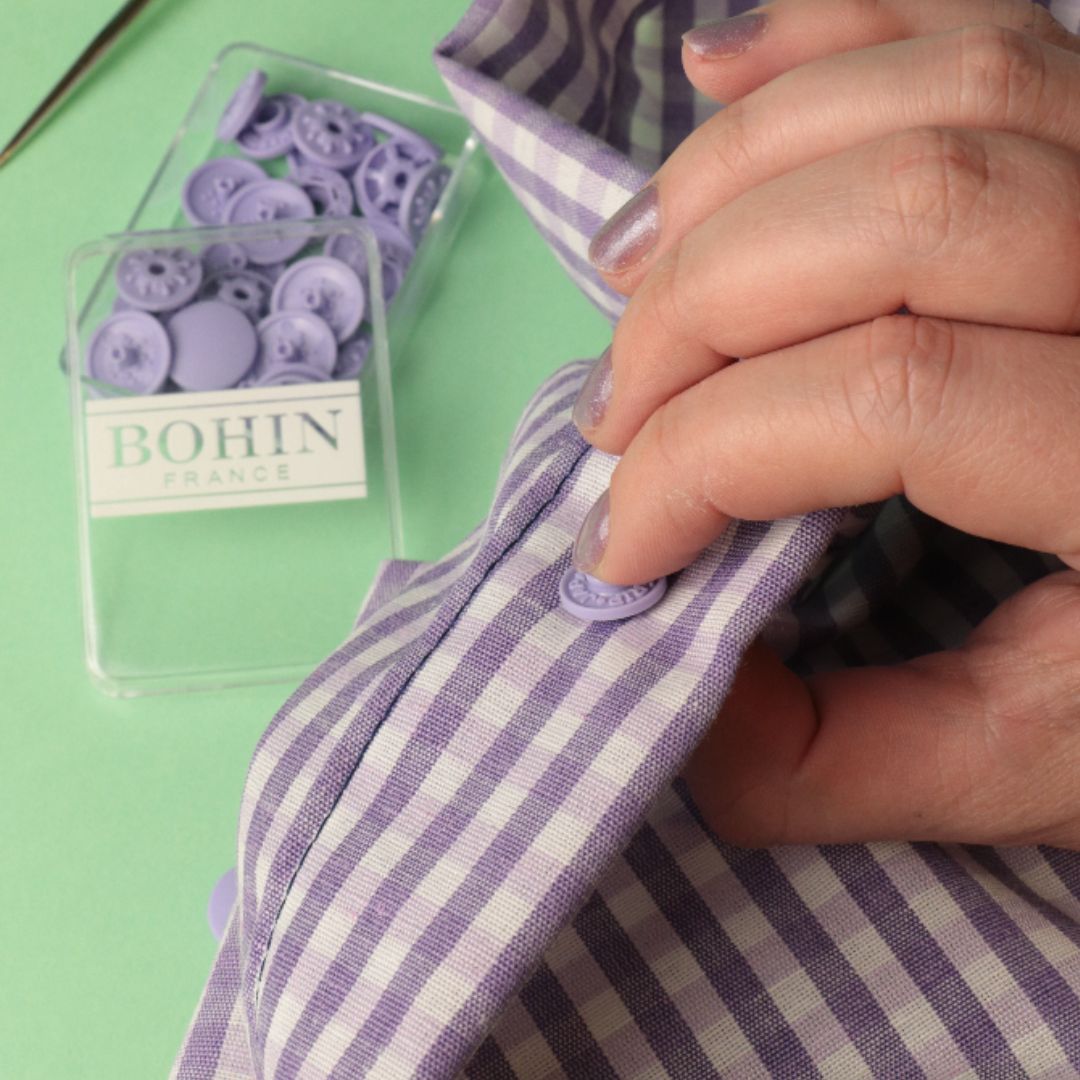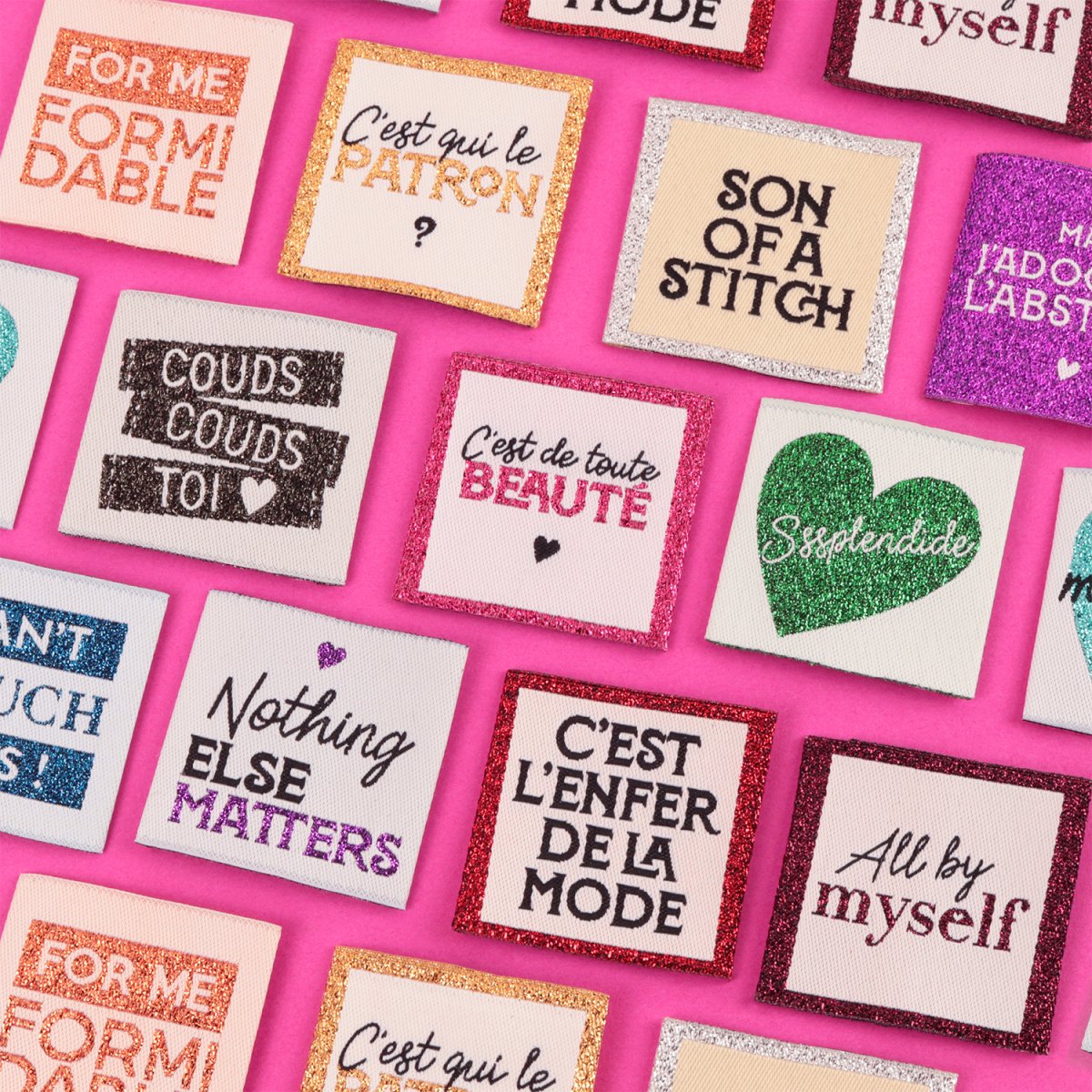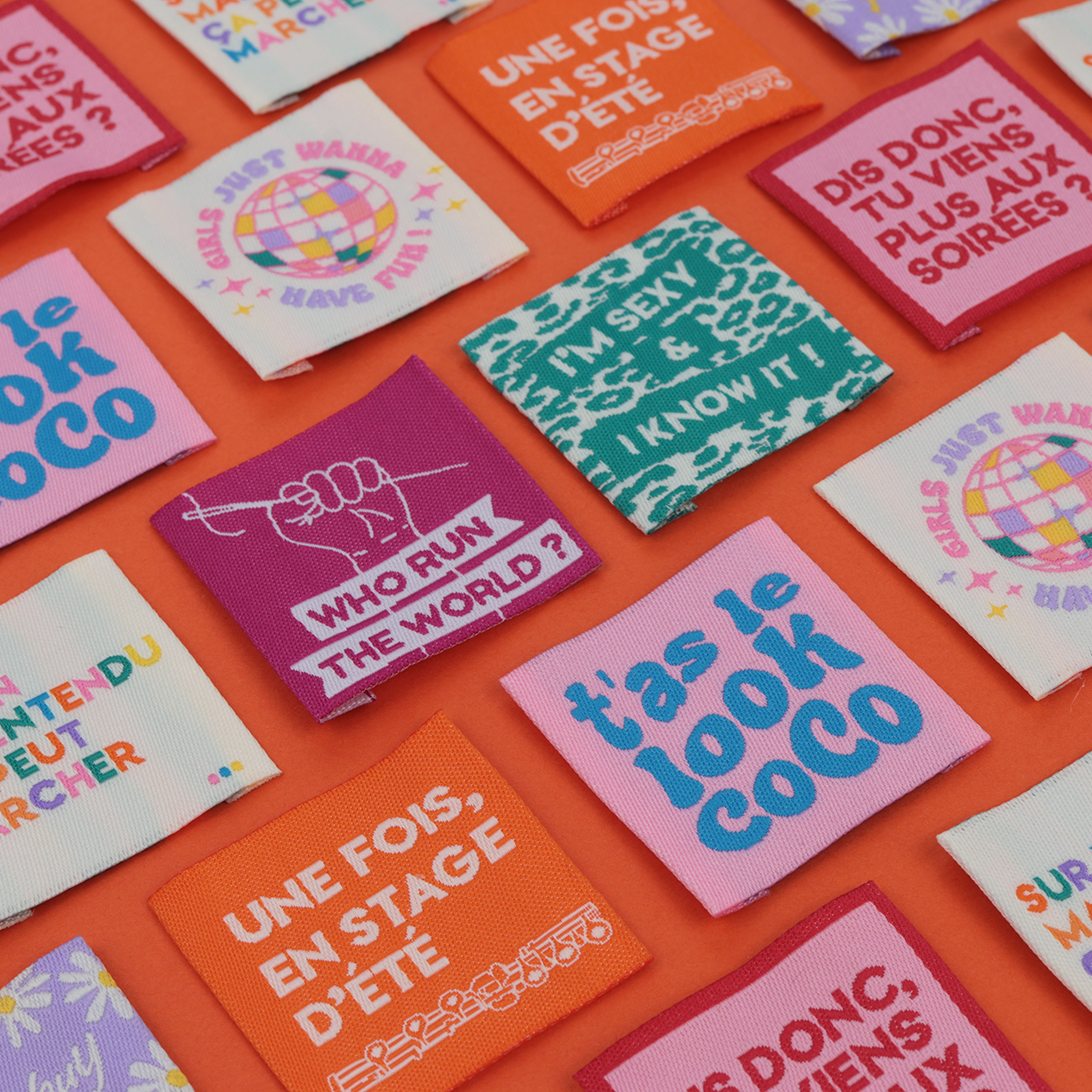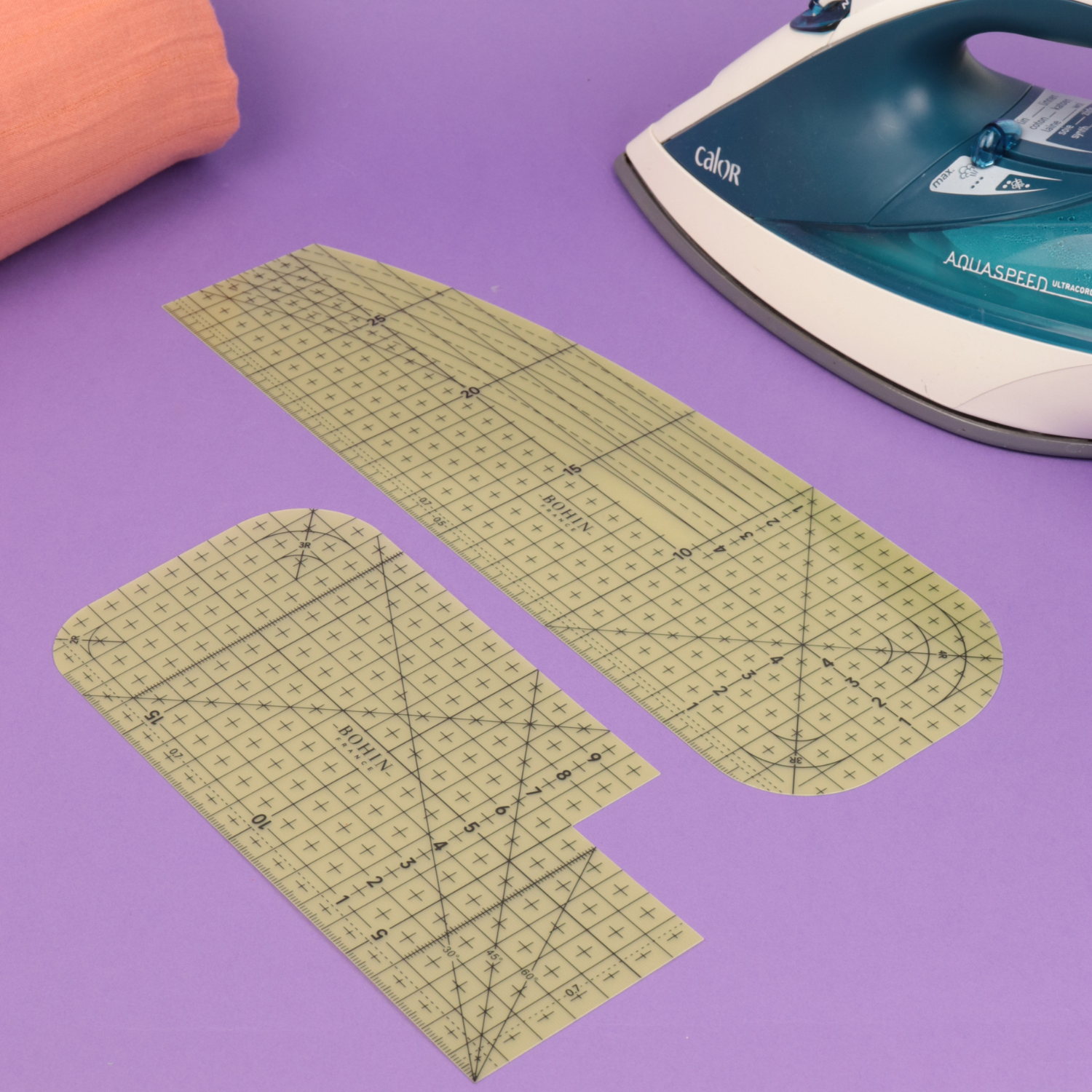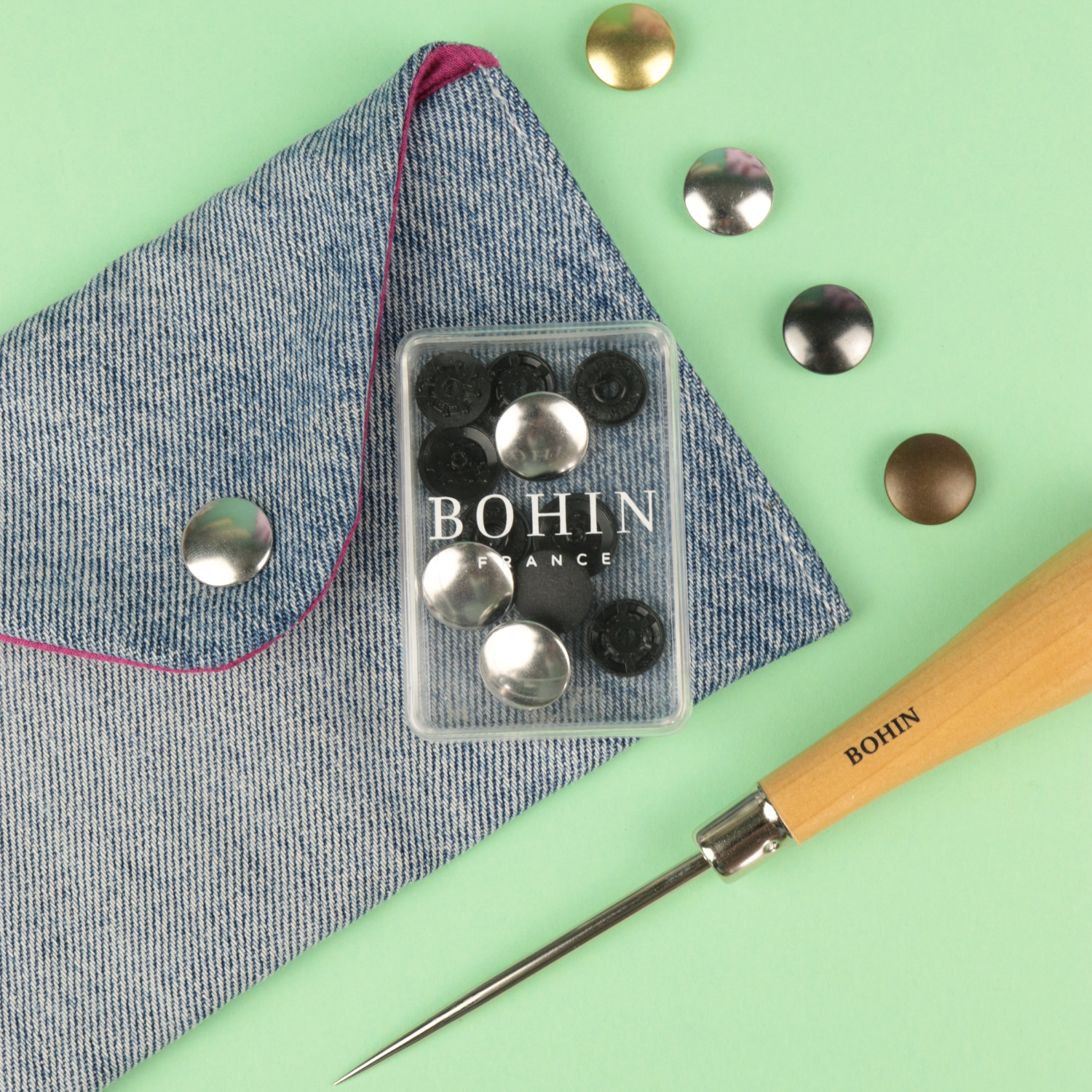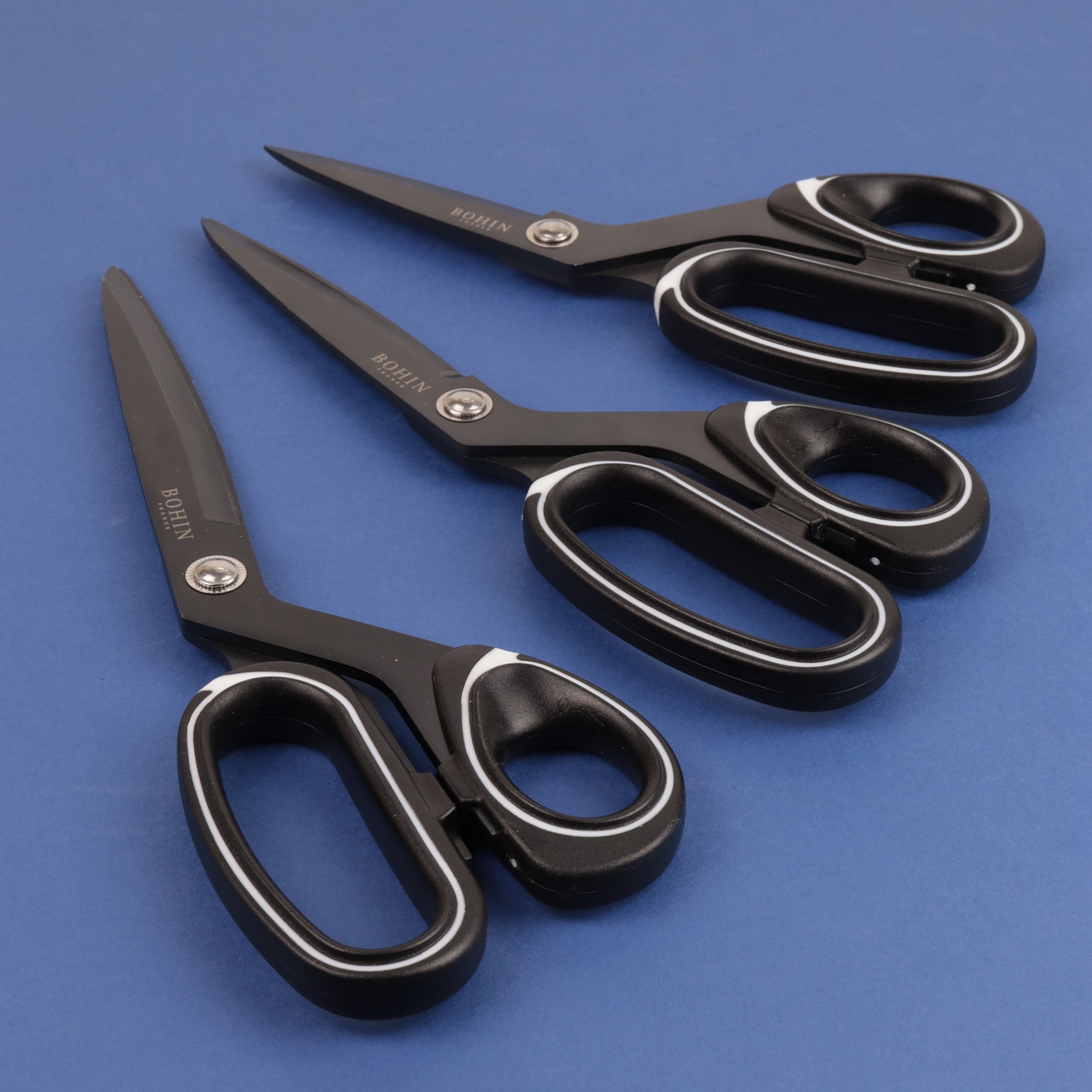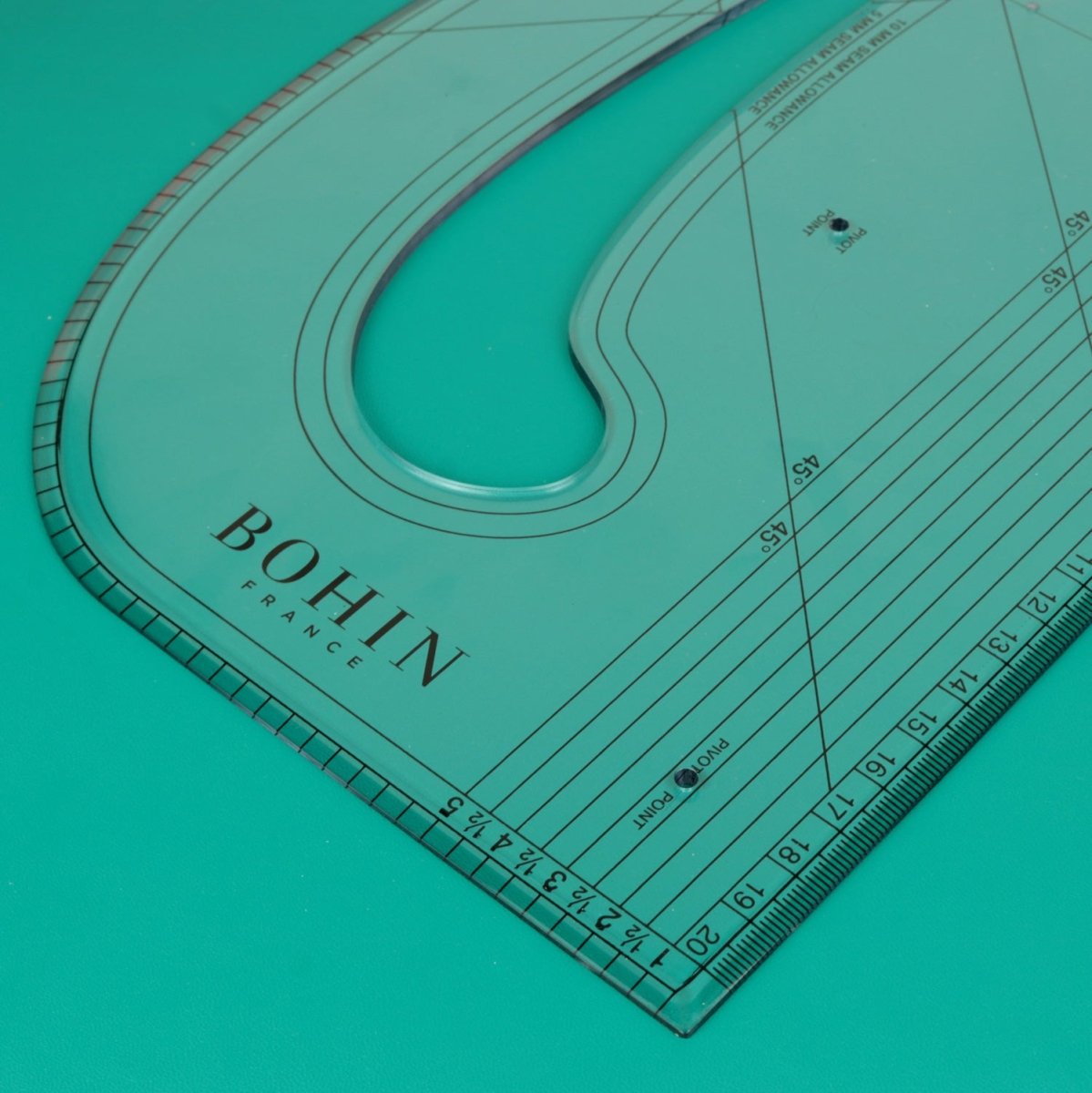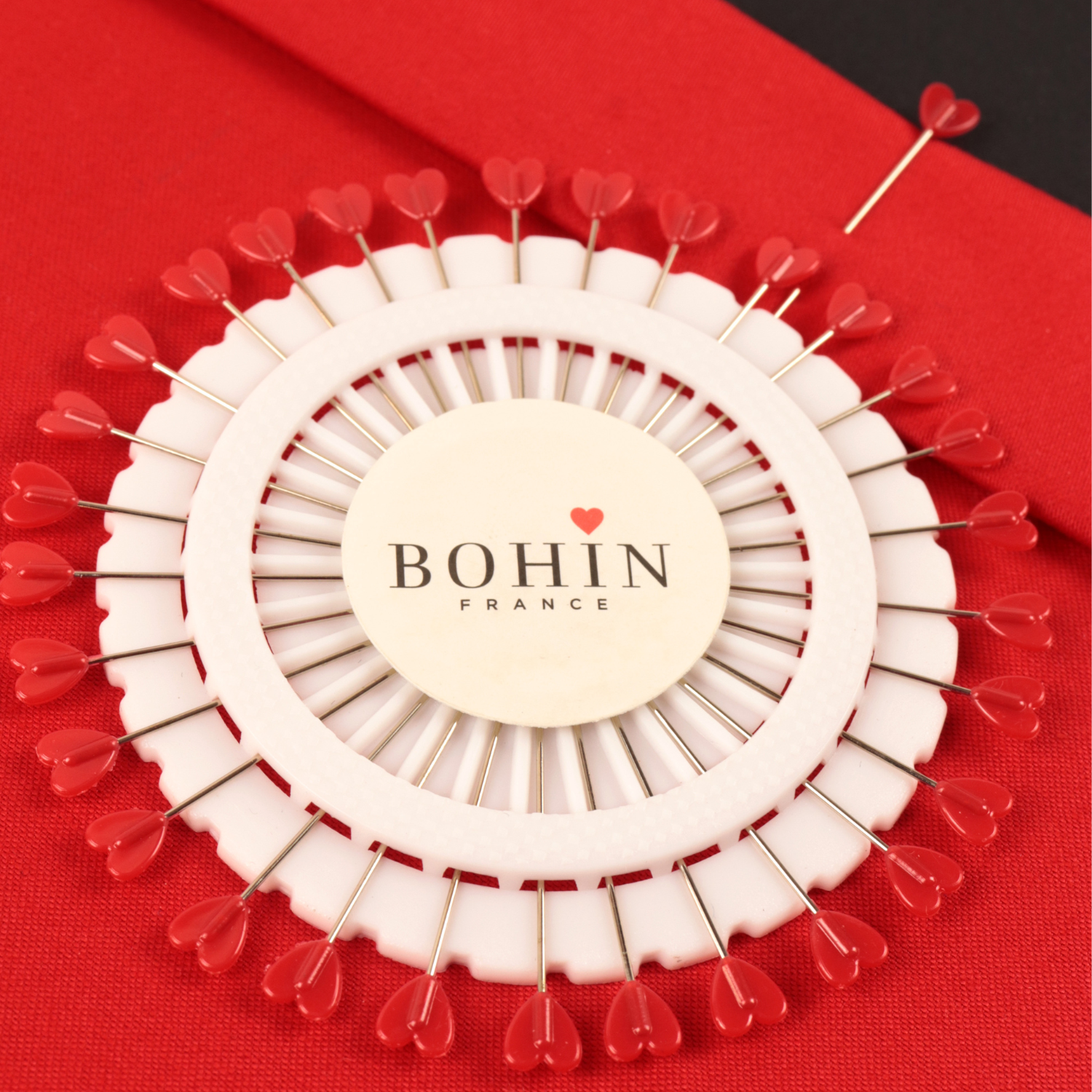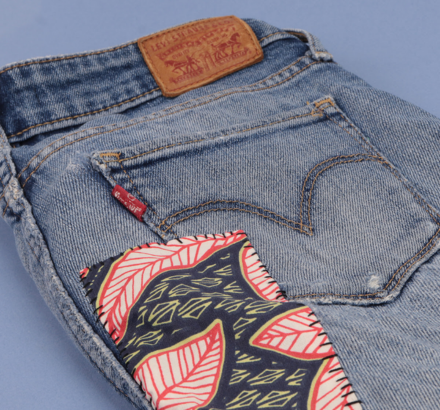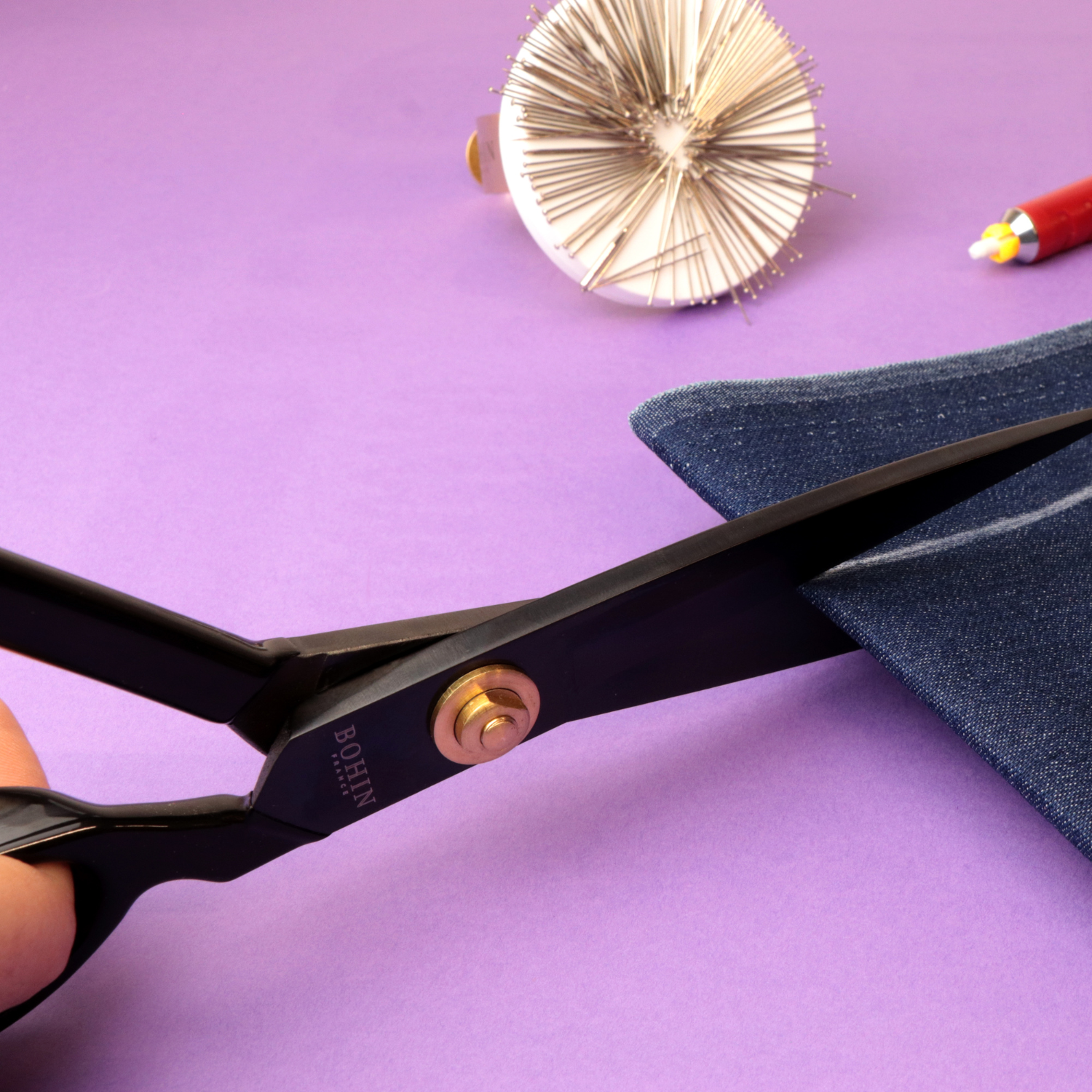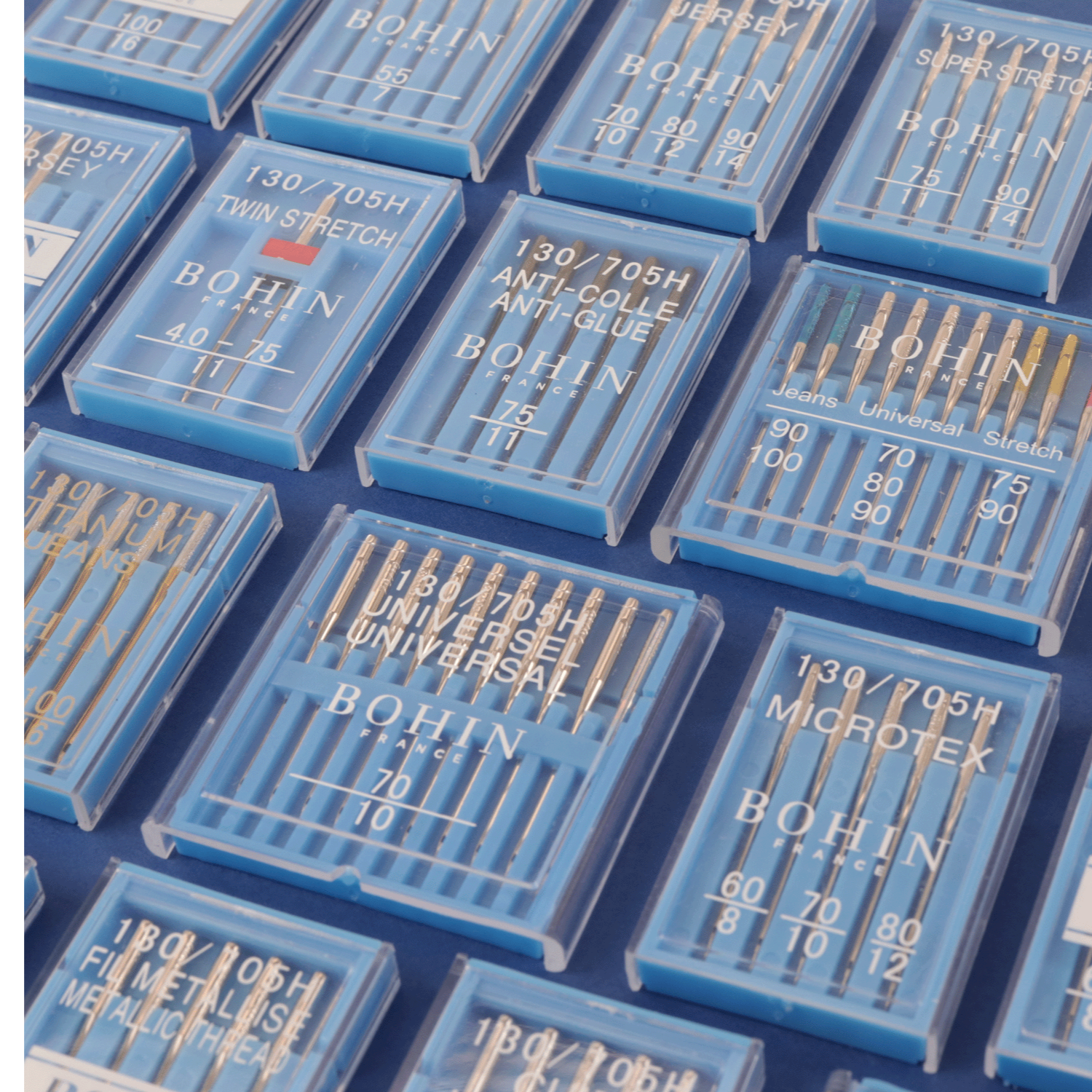
How to choose sewing machine needles?
We sometimes find ourselves lost when faced with the diversity of machine needle references available. Your sewing machine manufacturer has advised you to buy their brand of needles, but what to do when it's not available? Sewing needles for family sewing machines, or household sewing machines, are standard! Whatever the brand of your family sewing machine (Singer, Brother, Bernina, Pfaff, etc.), BOHIN flat-shank needles will fit your machine perfectly.
Choosing a BOHIN sewing machine needle that fits my sewing machine.
The BOHIN machine needle range offers a wide selection of needles. The assortment of needles allows you to adapt to the extent of your creativity and the diversity of fabrics to be sewn!
A little vocabulary... A sewing machine needle is made up of a heel and then a tapered shank which ends in a point with an eye, allowing the sewing thread to pass through.
Before choosing the right needle for your project, you need to make sure you choose the right shank. BOHIN flat-shank needles are guaranteed to fit the vast majority of household sewing machines that run on electricity and are less than 60 years old.
There are several types of heels. This is the part that is essential in choosing the right needle for your machine! It is in fact the one that will be inserted into your sewing machine: the heel must have the right shape and size. This shape and size are expressed by a reference found on the sewing needle case. The most common heel reference for family sewing machine needles is 130/705H. If this flat heel reference* is recommended for your sewing machine, then BOHIN machine needles will be compatible.
*If you don't know where to find this reference, it is normally indicated on the needle case that you received with your machine.
Which sewing needles should you choose for which use?
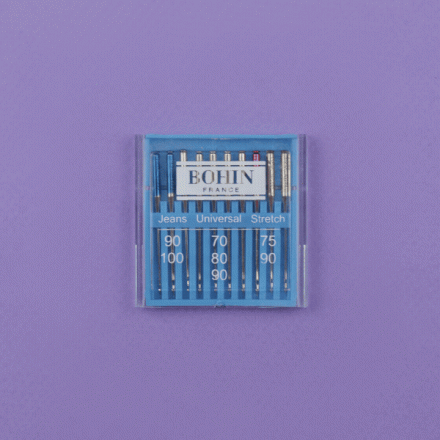
Now that you know what type of sewing needles to choose for your sewing machine, how do you choose the right size? This will depend on your sewing project. The needle adapts to the fabric (its material and thickness) and the thread used. Except for overcasting, you don't sew only one thickness of fabric. You must therefore think about adapting the size of your needle to the possible multiple thicknesses of fabric. Ideally, you should always test it on a scrap. This will also allow you to adjust the thread tension and stitch width. It is the condensed thickness that will be taken into account when inserting batting. This is why we talk more about weight than actual thickness.
Sewing is not an exact science. Weight classifications are provided for guidance only. There is no substitute for experience.
What do the “sizes” on needle cases mean?
Sewing needle diameters are expressed in two different ways: There is an international nomenclature in tenths of a millimeter. In the sewing needle range, the finest, suitable for the most delicate fabrics such as silk, is noted 55. The largest, for many thicknesses and upholstery fabrics, is noted 120. The Singer sewing machine brand has its own way of noting sizes. The equivalent of 55 is size 7. The equivalent of 120 is size 19. There is a real concordance between Singer and international sizes, for sewing machine needles of identical heel size. The BOHIN France brand has chosen to carry both sizes on its cases. They are offered one above the other, at the bottom of the case.
COME ON, WE'LL HELP YOU FIND YOUR WAY!
1/ Non-stretch fabrics (also called warp and weft): universal points
Non-stretch fabrics are fabrics that have a straight grain, which are woven with warp and weft threads. Standard needle points are suitable for these fabrics. The treatment of standard needles allows good resistance when sewing fabrics. They are both strong and flexible. Standard fabrics include: poplins, cottons, cretonne, pique, terry cloth, flannel, cambric, velvet, voile, twill, canvas, satin, etc. These types of fabrics are sometimes combined with other materials (linen, cotton, polyester, viscose, etc.). Certain materials influence the choice of needle. Keep in mind that as long as your fabric does not stretch in the straight grain, you can use a standard sewing machine needle. However, there are special points suitable for certain types of fabric.
The advantage of standard needles is that they come in a wide range of sizes. They are easy to adapt to different fabric weights. If you are new to sewing, the easiest way is to start with one of the assortments of machine needles in packs of 5 or 10, which includes the three most common sizes: 70, 80, and 90 (equivalent to Singer sizes: 10, 12, and 14). These will allow you to test different sizes on your fabrics. The ones you use most will be the ones you will need most frequently. You will then simply need to take the needles you use in packs of 10 of the same size to keep them available regularly and, above all, to store them and find them easily.
Sizes 70, 80 and 90 (equivalent to Singer sizes 10, 12 and 14) are for fairly light and medium-weight fabrics. Size 70 (the thinnest) is suitable for light fabrics, while size 90 (a little thicker) is suitable for medium-weight fabrics. This assortment will allow you to sew fabrics with weights between 100g/m 2 and 250g/m 2 .
BOHIN standard needles are available from size 55 (equivalent to Singer size: 7) to size 120 (equivalent to Singer size: 19).
They each have their own specificities. Needles suitable for the finest fabrics have the smallest sizes and needles suitable for the thickest fabrics have the largest size.
Needles 55 (equivalent to Singer size: 7) are suitable for fine, light and airy fabrics such as chiffon and voile as well as silk fabrics. Machine needle size 60 (equivalent to Singer size: 8) will be suitable for sewing gauze (not to be confused with double gauze) and voile as well as fabrics of less than 120g/m 2 . Size 70 (equivalent to Singer size: 10) is suitable for light fabrics (150g/m 2 max) such as double gauze, viscose crepe, batiste. Size 80 (equivalent to Singer size: 12) is suitable for medium fabrics (between 150g/m 2 and 200g/m 2 ) such as poplin. Size 90 (equivalent to Singer size: 14) is suitable for slightly heavy fabrics (between 200g/m 2 and 250g/m 2 ). Size 100 (equivalent to Singer size 16) is suitable for heavy fabrics (250g/m 2 to 350g/m 2 ). Size 110 (equivalent to Singer size 18) is suitable for very heavy fabrics (350g/m 2 to 400g/m 2 ). For your family sewing machine with a suitable motor, sewing machine needles no. 120 (equivalent to Singer size: 19) will allow you to sew the thickest fabrics (over 400g/m 2 ).
Weights are given as a guide only. Nothing can replace experience. However, these guidelines can serve as a guide.
If you are unsure about the size of a sewing needle, and it is no longer in its case, the diameter is indicated on the heel. This writing is often found to be too small, but it is nevertheless very useful and accessible under good light or with a good magnifying glass.
2/ Special tips
There are woven fabrics, and then there are all the others! It's best to always have the right needles for the right fabric types and to be familiar with fabric manufacturing in order to select the right needle. Some needles will have a point or treatment adapted to certain materials or techniques. The goal of these special sewing machine needle points is to provide you with the means to sew pleasantly and for the best result all your creative ideas. These different special sewing needles each have their specific uses. They are not reserved for experienced seamstresses. Special sewing needles are precisely the ideal tools to improve your skills for your sewing projects.
LEATHER / SPECIAL LEATHER
Needles suitable for leather have a special point that makes it easier to pierce the material. Similar to the triangular-point needles used on hand sewing needles, leather sewing machine needles allow you to sew the material without pre-piercing it. The material is perforated and remains smooth. There are no stamping marks like with an awl.
Special leather sewing needles can also be used for sewing oilcloth and coated fabrics. A Teflon foot, to be chosen according to your sewing machine, will also help the material glide smoothly on your sewing machine.
Also consider matching the thread to your sewing. A strong thread will be very useful; for example, you can choose denim thread or a very strong cotton thread. Waxed thread is not recommended for use on a sewing machine.
STRETCH
Many fabrics today contain a stretchy material. This material is a thread that makes up the fabric. This is why warp and weft fabrics are stretchy because they contain nylon, elastane, Lycra, or certain polyesters. A stretchy fabric is recognized because it stretches in all directions.
Sewing stretch requires stretching the fabric significantly, which, on standard needles, puts additional stress on the needle. This can cause the standard needle to break because the fabric's tension will bend the needle beyond its capacity. Special stretch needles have a special treatment that gives them greater flexibility while remaining durable. They are available in a range for lightweight and medium-weight fabrics.
Stretch fabrics tend to roll up at the edges. They are therefore difficult to hem. Twin Stretch double needles are suitable for double stitching to properly flatten the fabric against the body. BOHIN Twin Stretch needles are size 75 (equivalent to Singer size 11). They are designed for hemming and double stitching fine technical fabrics, especially for sportswear. All sewing machines are suitable for using double-pointed needles. The top seam will have two parallel lines. The bottom seam will look like an overlock stitch since there is a single bobbin that will loop the two top threads.
If a jersey fabric is made of synthetic material, depending on the degree of elastic material inside, its elasticity rate, it can be sewn like a stretch fabric or jersey fabric. Similarly for stretch jeans, assembly seams can be made with a size 90 stretch needle (equivalent to Singer size: 14), for hems or multiple thicknesses such as topstitching, it is preferable to use the BOHIN jeans needle size 100 (equivalent to Singer size: 16).
JERSEY
Jersey is a stretchy fabric because it's knitted, not woven. Jersey stretches in one direction only, across the width, not the height. It's still possible to find jerseys without stretch material. But they often contain a little elastane. However, they can be sewn primarily like jersey.
The point of jersey needles is rounded to pass through the stitches of the fabric and not between the fibers. This helps maintain the fabric's elasticity. Sewing jersey with standard needles, even with a zigzag stitch, can cause your seams to tear because they won't maintain the fabric's elasticity. The range of special jersey sewing needles is available for lightweight and medium-weight fabrics.
The Twin needle is designed for hemming fine jerseys. These fabrics can be difficult to hem. Twin needles are suitable for double stitching to properly flatten the fabric against the body. The Bohin Twin needle is a size 80 (equivalent to Singer size 12). It is designed especially for parallel stitching on t-shirts and medium-weight clothing fabrics. All sewing machines are suitable for using double-pointed needles. There are different tutorials from sewing machine manufacturers for threading the two threads. The top seam will have two parallel lines. The bottom seam will look like an overlock stitch since there is a single bobbin that will loop the two top threads.
If a jersey fabric is made of synthetic material, depending on the degree of elastic material inside, its elasticity rate, it can be sewn as a stretch fabric or jersey fabric.
JEANS
Denim fabric is a practical, comfortable, and durable material. It's a noble material with an important specificity in its weave. It is indeed very tight and very resistant. This is why there are needles adapted to it with a very fine point to pass through the wefts of the fabric, and it is also strong to pierce the thick material.
The needles suitable for BOHIN jeans are size 100 (equivalent to Singer size 16). These are the most useful for assembling and topstitching durable jeans, the classic denim fabric. These special sewing needles can be used for both sewing and repairing jeans. They can also be used to adjust a two-ply hem, redo a denim topstitch or repair a tear on jeans using a repair patch or jersey percale if your fabric is stretchy.
There are now denim fabrics that contain stretch. Depending on the degree of elasticity and the weight of the jeans, some stitching can be done with a size 90 stretch needle (equivalent to Singer size 14). Needles suitable for denim are still recommended for topstitching and multiple layers (attaching the waistband, applying pockets, etc.).
When sewing your jeans, consider using the special denim thread, which has a specific contrasting ochre color. This durable thread is suitable for size 100 needles (equivalent to Singer size 16) and has a traditional color that complements the blue of classic jeans.
ANTI-GLUE
Glues are very useful sewing tools because they allow you to stabilize two fabrics against each other and sometimes also stiffen fabrics that are then sewn to others. On the other hand, glues can, during sewing, transfer to the needle or even to the machine, with the risk of clogging and damaging it. A needle with glue on its shank will pass less well through the fabrics. It risks marking the fabric more strongly as it passes and thus damaging the fabric.
The anti-glue needles have a special non-stick coating that gives them perfect glide on glued surfaces (adhesive spray, temporary or permanent textile glue, hook and loop strips, etc.). The anti-glue needles are available in an assortment for medium-heavy and heavy fabrics. A case also allows you to carry out your work for more delicate and fine projects.
Anti-glue machine needles allow you to sew glued materials without clogging the machine or the needle. They are suitable for sewing appliqués on clothing and patchwork.
PATCHWORK
While quilting is traditionally done with a half-length hand sewing needle, there are many tools available to make machine quilting easier. The patchwork machine needle assortment allows you to create the top of your quilt with light or medium-weight fabrics. The fine point of these needles allows for small seams, with a shorter stitch length than usual, to create strong seams.
For quilting, you can use special patchwork sewing needles or Top Stitch needles. These needles are suitable for creating geometric or fancy quilting to assemble your top, bottom, and batting. You can then put your sewing machine in free-motion mode to create patterns from the simplest to the most elaborate. Top Stitch needles are suitable for making quilts using the crazy method and for thicker fabrics.
For quilting thick fabrics, you can also use standard needles in sizes 100, 110, or 120 (equivalent to Singer sizes 16, 18, and 19), depending on your machine's capabilities. Patchwork is a fabulous opportunity to give new life to upholstery fabrics. You can also use a bulkier batting.
EMBROIDERY
Do you have an embroidery machine? Do you want to create free-motion machine embroidery? Choose our embroidery needles. They have a larger eye to facilitate thread passage. Our embroidery machine needle assortment comes in two sizes. Size 75 (equivalent to Singer size 11) allows you to create fine embroidery with a small amount of thread, while size 90 (equivalent to Singer size 14) allows you to embroider thick fabrics with denser threads.
Embroidery sewing machine needles allow you to use a variety of fancy threads. To further facilitate your creativity, BOHIN also offers embroidery needles with metallic thread. This particularly slippery and fragile thread will be held securely in these specially adapted needles. Size 80 allows you to create fine embroidery with a small amount of thread. Choose size 90 (equivalent to Singer size 14) for embroidering thick fabrics.
MICROTEX
Microtex needles are technological gems. They are the perfect needle for all non-stretch technical fabrics. Microtex sewing machine needles are suitable for specific uses and particularly delicate fabrics. Whether fragile or fine, fluid or brittle, the Microtex machine needle assortment provides solutions for sewing difficult fabrics. This is the machine needle assortment to try if you're looking for a last resort for a particular fabric.
Microtex needles are used for sewing fine microfibers, making with fluid viscose, repairing tent or kite canvas, and making paper piercing in patchwork. Even very fragile silk or polyester satins can be sewn with the appropriate Microtex needles.
The Microtex machine needle assortment offers a wide selection of needle sizes 70, 80 and 90 (equivalent to Singer sizes 10, 12 and 14). These are the most common sizes for light to medium-weight fabrics.
VISCOSE
Combining softness, finesse, heat regulation, and lightness, viscose is a very common material in haberdashery fabrics. It also often has a lovely drape and fall that has won over many. However, viscose is often a delicate material, very fluid and therefore a little complicated to sew.
First, pin your viscose fabric well. You can also starch your fabric to stiffen it. There are products for this, but it's easy to do at home with cornstarch, for example.
For sewing viscose fabrics, we suggest you try our Microtex needles. The advantage of this machine needle assortment is that it offers the same sizes as the standard machine needle assortment. The assortment is therefore suitable for light, medium, and medium-heavy fabrics.
Which needles should I buy to start using a sewing machine?
First of all, congratulations on the start of this wonderful creative adventure! The ideal place to start is with an assortment of machine needles. There are different ones depending on the type of points. The combi sewing machine needle case includes different types of needles in terms of size and points. In addition to standard point needles, you can also try the special jeans points (blue heel, in sizes 90 and 100) and the stretch points (size 75 (equivalent to Singer size: 11) in yellow and 90 (equivalent to Singer size: 14) in pink). The needles are available in the classic sizes of standard needles: 70, 80 and 90 (equivalent to Singer size: 10, 12 and 14). This is the ideal assortment to start sewing with your family sewing machine.
If you want to start with non-stretch fabrics using standard household sewing machine needles, you can choose one of our machine needle assortments. These assortments, consisting of 5 or 10 needles, cover the most common sizes. The 5-needle assortment is for infrequent use or small projects. The 10-needle assortment is for longer projects, such as clothing. Sometimes you'll need one needle to complete a single project. Sometimes, one needle will do a single project. When you're tackling a large project (trousseau, wedding dress, coat, suit, etc.), you'll need several needles to complete your project.
Special pointed needles are also frequently available as a set. This allows you to start working with jersey, stretch, denim, etc.
Some tips for using and storing your sewing machine needles properly
The time of use of a needle
Needle points become dull over time. On average, a high-quality sewing needle is considered to have an optimal lifespan of 8 hours. Beyond these 8 hours, the point is less effective. Your stitches will be less consistent. If used for too long, your needle may break and even damage your sewing machine.
Maintaining your sewing machine
It's still advisable to have your sewing machine serviced every year (just like you would your car) if you use it regularly. Also, remember to clean it of any textile dust that gets stuck inside and oil the gears.
Storing your sewing needles
Given the lifespan of a sewing needle (8 hours of sewing before the point becomes dull), we recommend setting up a storage system to differentiate new needles from those that have already been used. You can make a needle book where you will indicate the needle size and point type in larger letters than on the heel for easy use. Making this type of needle book, whether for sewing machine needles or hand sewing needles, is an excellent project for beginners in sewing. You can also set up a visual storage system within your case. For example, by placing the flat heel or the round side of your needle on top of your case to identify those that have already been used.
